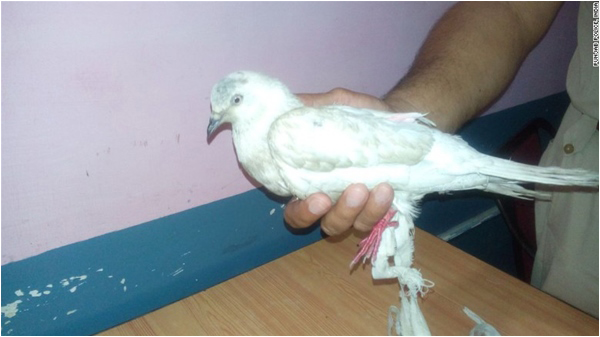
There was once a Sikh gentleman from India who came to Pakistan in order to visit the Sikh holy sites. It just so happened that he died in the midst of his pilgrimage. There was nothing sinister about the death; the man was old enough, and it wasn’t much a surprise that he had passed away while performing a religious ritual, though having done it in an enemy country did complicate matters slightly. His body was put in a coffin and sent back to the border from whence it came. As with most other things, it was at the border that the trouble started. The Pakistani authorities sent the coffin containing the body a few meters or so into the Indian side but the Indians refused it entry. There was much humming and hawing, searching and prodding until the Indian border agents finally said that the reason the body couldn’t come back was because the deceased’s visa only allowed an “On-Foot” crossing and the man was, demonstrably, not on his feet.
The matter was finally resolved when an ingenious citizen suggested they stand the coffin upright, and then shuffle it across the border so it abided by the visa requirements. This is not a joke — I have it on very good authority.
The reason this story came back to me this week was because, like everyone else, I read the news report about the Indians detaining a pigeon that had been captured by a boy in a village close to the border. The bird was under suspicion of being a spy because there was allegedly some Urdu message scribbled on it along with a Pakistan phone number. I laughed hard and with abandon, like one does when someone you compete with is shown up slightly. First off, how do you even write on a pigeon’s feathers? Anyone who made a quill out of bird feathers as a kid in an effort to pretend they were in a middle-ages crime novel (I refuse to believe this was just me) knows first hand that you can’t really do it. Unless they print on the bird. (Can you do that? Can you print on a bird? That would be amazing.) Second, how embarrassing is it that two nuclear powers who spend more on their armies than they do on either healthcare or education resort to something as low-tech as pigeons to carry out espionage. Whatever happened to vixens and vagabonds passing information through morse code? Whatever happened to the glamour of international relations?

Slowly, however, it sank in that, jokes aside, this could be a very plausible news report. A pigeon could very well have been used to send a message across the border; and why not? Courier pigeons were like email in ages past. Rome used them; Changez Khan used them. The Babylonians, the Egyptians, the Mesopotamians, the Persians, the Mughals, the French. (The French still eat them, of course.) Everyone who was anyone who wanted to kill everyone used a pigeon to relay information. They are incredibly precious birds, and not just when dunked in butter.
When I was in Morocco on a hike in the Atlas Mountains, my tour guide was playing up the whole “Mysterious Arabia” bit. In a voice meant to remind white people of the voiceover from Aladdin movies, he told me stories of how gangs would smuggle drugs from the Middle East to Morocco for eventual sale in Europe. The smugglers would first lead a camel through the desert without giving it food, but then feed it at the desired destination and send the camel back. This way the camel associated the route and destination with food, and so could be laden with drugs and sent off into the dunes unaccompanied and be trusted to arrive on the other side, all the while avoiding detection. All the smuggler would have to do is arrive at the chosen destination and wait for the camel. It’s genius, and a method as old as the dunes themselves, he told me.
So why not pigeons? Of course, this isn’t to suggest that we did send a spy; for shame! We would totally never do that. (No, we’re more likely to send a bunch of armed fanatics on a boat...) Still, the next time we are trying to figure out how the Taliban and their supporters keep in touch when it isn’t thorugh email, it may behoove us to look to the skies.
Write to thekantawala@gmail.com and follow @fkantawala on twitter
The matter was finally resolved when an ingenious citizen suggested they stand the coffin upright, and then shuffle it across the border so it abided by the visa requirements. This is not a joke — I have it on very good authority.
Courier pigeons were like email in ages past
The reason this story came back to me this week was because, like everyone else, I read the news report about the Indians detaining a pigeon that had been captured by a boy in a village close to the border. The bird was under suspicion of being a spy because there was allegedly some Urdu message scribbled on it along with a Pakistan phone number. I laughed hard and with abandon, like one does when someone you compete with is shown up slightly. First off, how do you even write on a pigeon’s feathers? Anyone who made a quill out of bird feathers as a kid in an effort to pretend they were in a middle-ages crime novel (I refuse to believe this was just me) knows first hand that you can’t really do it. Unless they print on the bird. (Can you do that? Can you print on a bird? That would be amazing.) Second, how embarrassing is it that two nuclear powers who spend more on their armies than they do on either healthcare or education resort to something as low-tech as pigeons to carry out espionage. Whatever happened to vixens and vagabonds passing information through morse code? Whatever happened to the glamour of international relations?

Slowly, however, it sank in that, jokes aside, this could be a very plausible news report. A pigeon could very well have been used to send a message across the border; and why not? Courier pigeons were like email in ages past. Rome used them; Changez Khan used them. The Babylonians, the Egyptians, the Mesopotamians, the Persians, the Mughals, the French. (The French still eat them, of course.) Everyone who was anyone who wanted to kill everyone used a pigeon to relay information. They are incredibly precious birds, and not just when dunked in butter.
When I was in Morocco on a hike in the Atlas Mountains, my tour guide was playing up the whole “Mysterious Arabia” bit. In a voice meant to remind white people of the voiceover from Aladdin movies, he told me stories of how gangs would smuggle drugs from the Middle East to Morocco for eventual sale in Europe. The smugglers would first lead a camel through the desert without giving it food, but then feed it at the desired destination and send the camel back. This way the camel associated the route and destination with food, and so could be laden with drugs and sent off into the dunes unaccompanied and be trusted to arrive on the other side, all the while avoiding detection. All the smuggler would have to do is arrive at the chosen destination and wait for the camel. It’s genius, and a method as old as the dunes themselves, he told me.
So why not pigeons? Of course, this isn’t to suggest that we did send a spy; for shame! We would totally never do that. (No, we’re more likely to send a bunch of armed fanatics on a boat...) Still, the next time we are trying to figure out how the Taliban and their supporters keep in touch when it isn’t thorugh email, it may behoove us to look to the skies.
Write to thekantawala@gmail.com and follow @fkantawala on twitter

